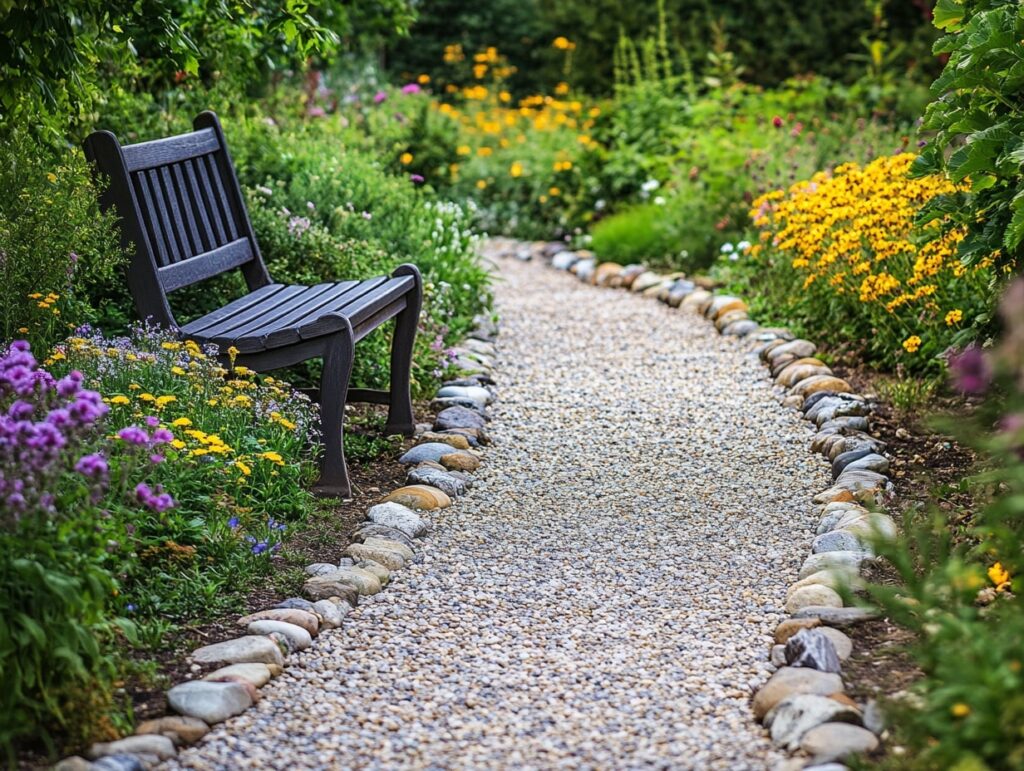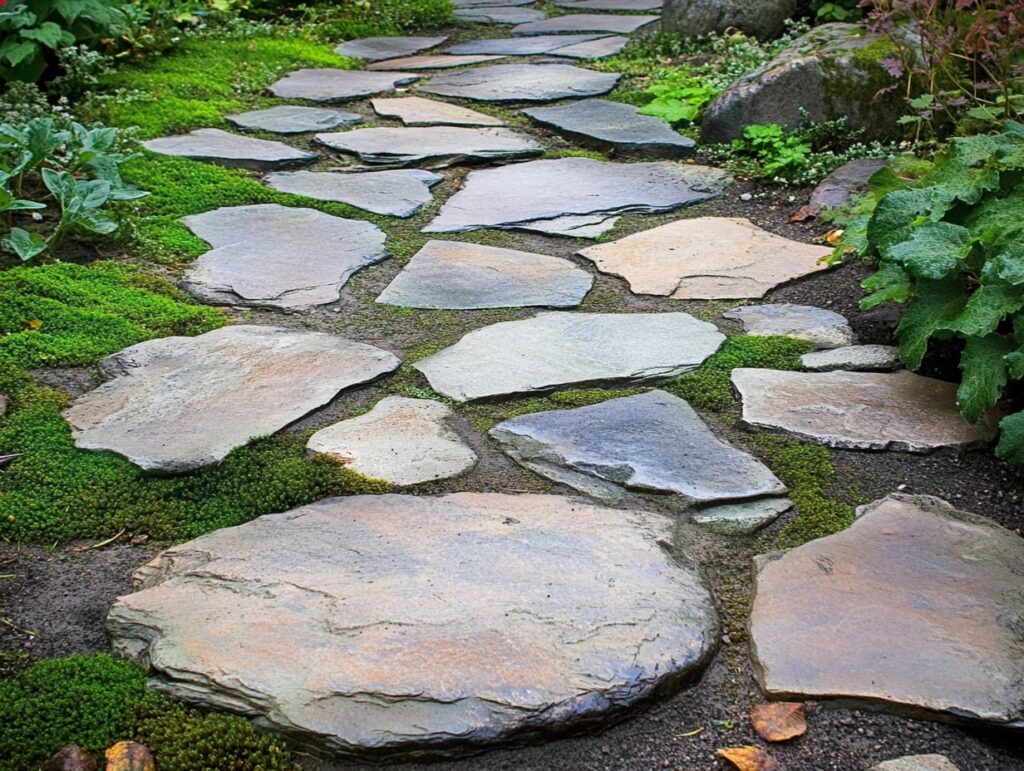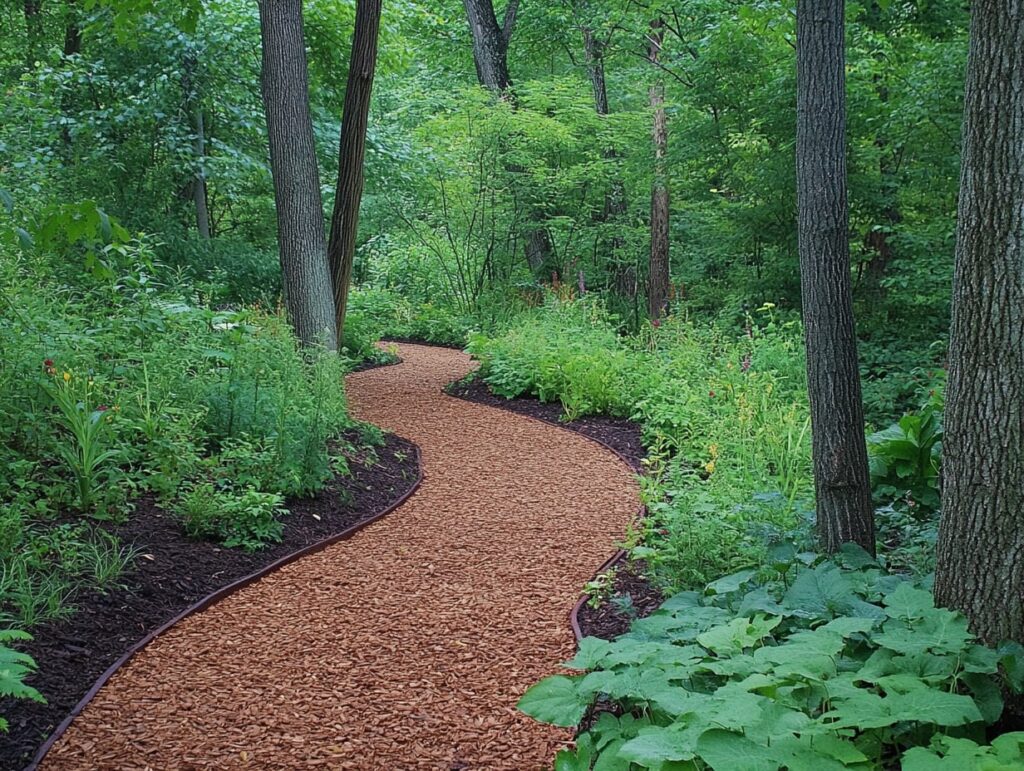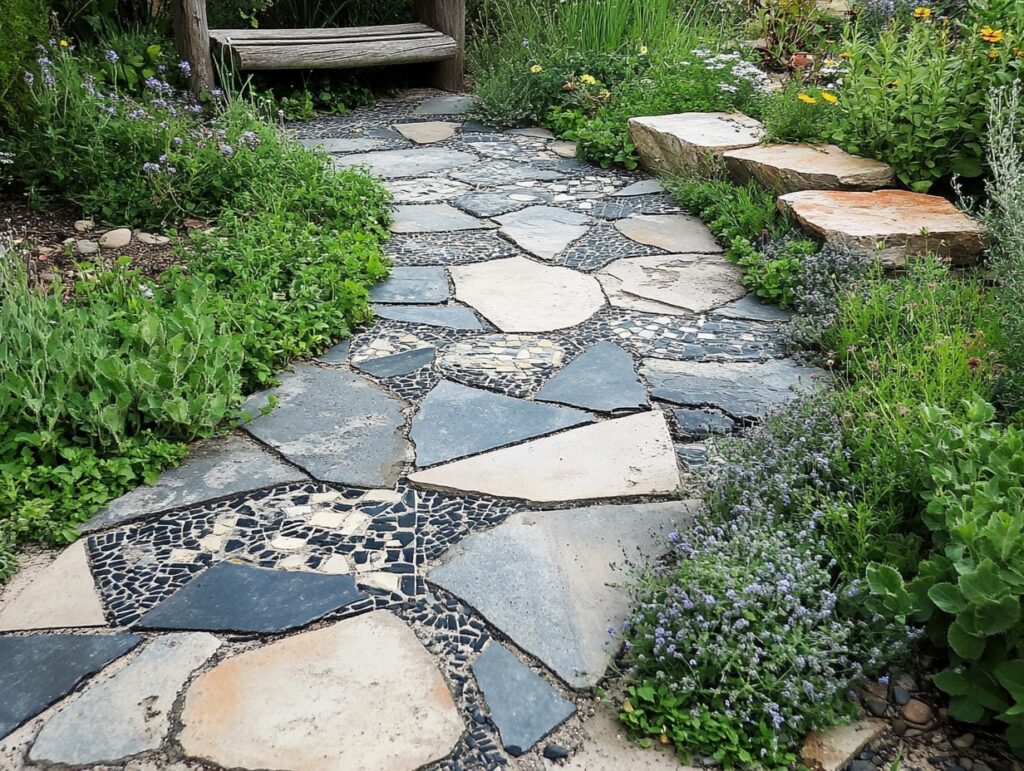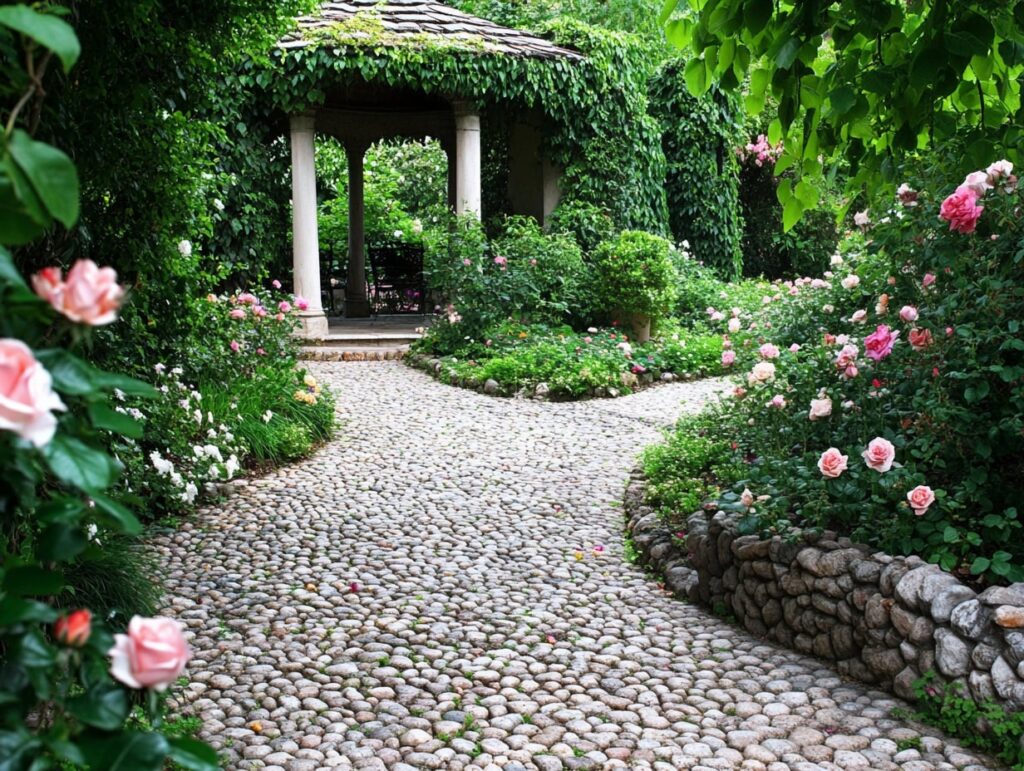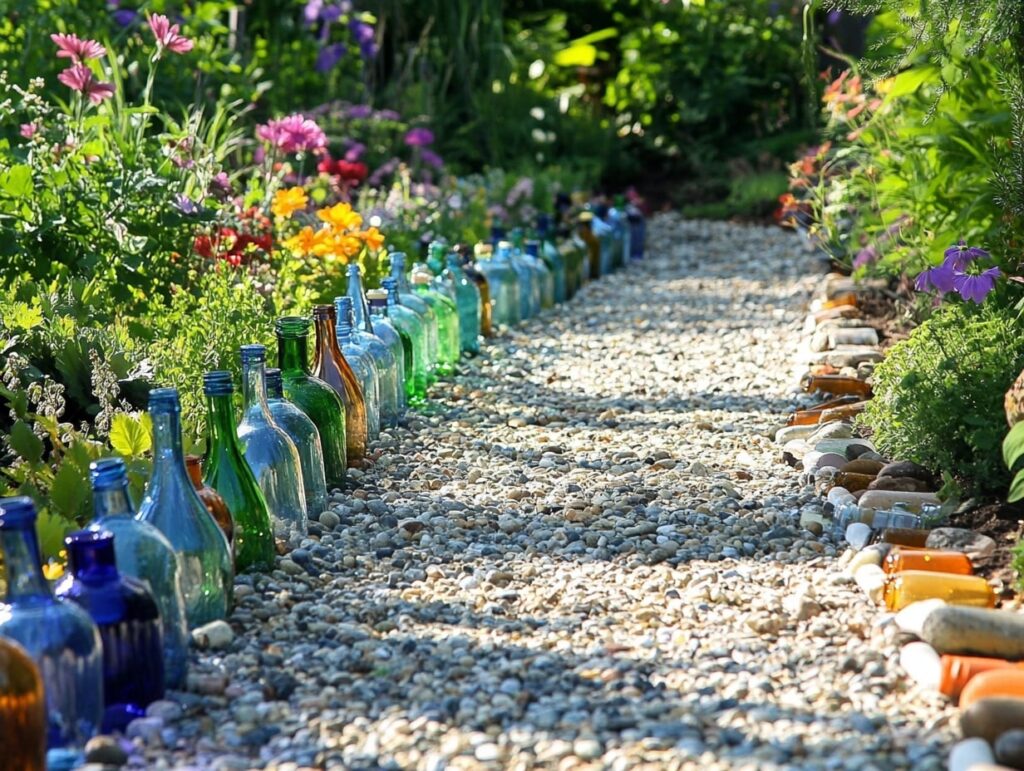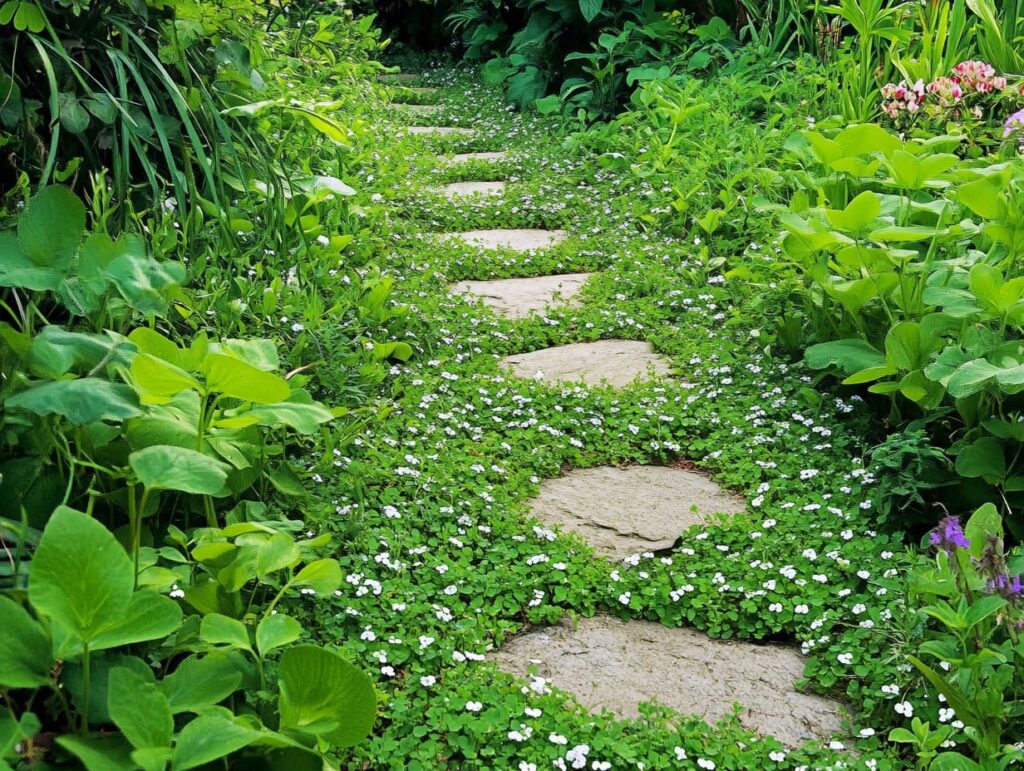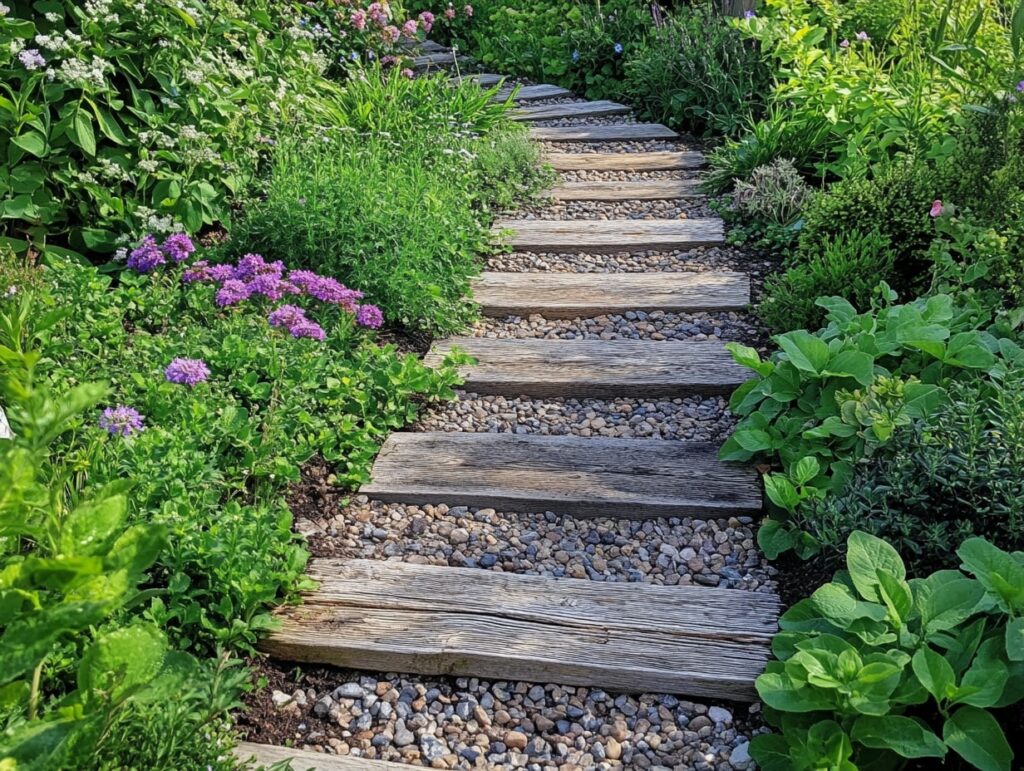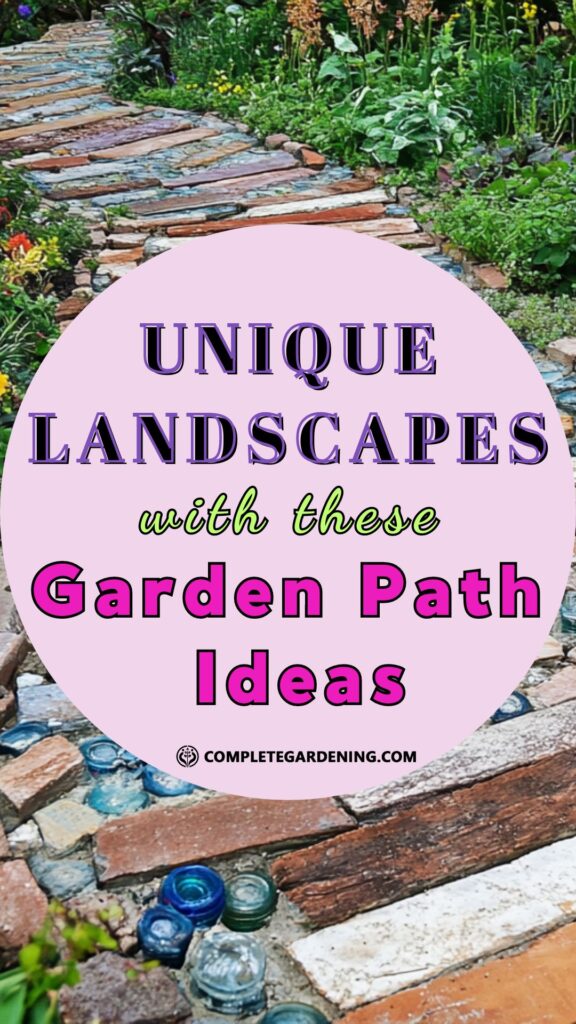Creating a delightful garden path can significantly enhance your outdoor space and make every stroll a pleasant journey. Embracing natural and recycled materials for your garden path adds beauty while promoting sustainability.
Imagine walking through your garden on a path crafted from reclaimed wood, old bricks, or natural stones, each step telling a unique story and reducing waste.
Natural materials like stone and wood textures can seamlessly blend your path into the landscape, creating a serene and cohesive environment.
Recycled materials, such as old bricks or repurposed concrete, not only help the planet but also add a rustic charm that is both unique and economical.
Choosing these materials is an excellent way to bring creativity to your garden design while being environmentally conscious.
Your garden path can become a personal project that showcases your dedication to both aesthetics and sustainability, turning an ordinary garden stroll into an extraordinary experience.
1. Gravel and Pebble Paths
Gravel and pebbles are among the most natural materials you can use for a garden path. They are easy to install, provide good drainage, and blend seamlessly with the surrounding landscape.
A gravel path can be as simple or as intricate as you like, depending on the size and type of stones you choose.
Advantages:
- Cost-effective: Gravel is relatively inexpensive and widely available.
- Versatile: It works well with both formal and informal garden styles.
- Low maintenance: Gravel paths are easy to maintain with occasional raking to smooth out any uneven areas.
Tips: To create a more stable and long-lasting path, consider laying down a weed barrier fabric before adding the gravel. Edging with natural stone or recycled bricks can help keep the gravel in place.
2. Wooden Plank Pathways
For a rustic and natural look, consider using wooden planks or logs as stepping stones or continuous paths through your garden. Reclaimed wood, such as old barn boards or pallets, can be repurposed into beautiful and functional pathways.
Advantages:
- Sustainable: Using reclaimed wood reduces waste and gives new life to old materials.
- Aesthetic appeal: Wood adds warmth and texture to your garden, complementing natural surroundings.
- Easy to install: Wooden planks can be laid directly on the ground or slightly elevated with supports.
Tips: Ensure the wood is treated or naturally resistant to decay, such as cedar or redwood, to prolong its lifespan. For added stability, secure the planks in place with stakes or anchors.
3. Stone and Flagstone Paths
Natural stone is a timeless choice for garden paths, offering durability and a classic look that fits into any garden style. Flagstones, in particular, are large, flat stones that can be laid directly on the ground, creating a stable and attractive pathway.
Advantages:
- Durable: Stone paths can last for decades with minimal maintenance.
- Natural beauty: Each stone is unique, adding character to your garden.
- Permeable surface: Allows water to drain through, reducing runoff.
Tips: Consider using locally sourced stone to reduce transportation costs and environmental impact. Recycled concrete slabs or broken pieces of old sidewalks can also be used as an eco-friendly alternative to natural stone.
4. Brick and Paver Paths
Bricks and pavers are another excellent option for creating a durable and visually appealing garden path. Reclaimed bricks, salvaged from old buildings or construction sites, add a touch of history and character to your garden.
Advantages:
- Recyclable: Bricks and pavers can be reused from other projects, reducing waste.
- Variety of patterns: Bricks can be laid in various patterns, such as herringbone or basket weave, to create interest.
- Long-lasting: Properly installed brick paths can last for many years.
Tips: If using reclaimed bricks, check for quality and ensure they are free from contaminants. A sand or gravel base is essential for preventing bricks from shifting over time.
5. Mulch and Wood Chip Paths
Mulch and wood chips are natural and inexpensive materials that can be used to create soft, rustic paths through your garden. These materials are particularly well-suited for informal gardens and woodland areas.
Advantages:
- Affordable: Mulch and wood chips are often available at low cost, especially if sourced locally.
- Nutrient-rich: As the mulch decomposes, it adds organic matter to the soil.
- Natural appearance: Blends seamlessly with garden beds and other natural elements.
Tips: Mulch paths may need to be replenished periodically as the material breaks down. A layer of landscape fabric underneath the mulch can help prevent weeds from growing through the path.
6. Recycled Concrete Paths
Concrete might not seem like a natural material at first glance, but using recycled concrete is an excellent way to repurpose a material that would otherwise end up in a landfill. Broken concrete, also known as urbanite, can be used to create unique and sustainable garden paths.
Advantages:
- Eco-friendly: Reusing concrete reduces the demand for new materials and lowers the environmental impact.
- Cost-effective: Recycled concrete is often available at a lower cost than new materials.
- Durable: Concrete paths are strong and long-lasting.
Tips: Arrange the pieces of concrete in an irregular pattern to mimic the look of natural stone. Plant groundcovers like thyme or moss between the cracks to soften the appearance and add greenery.
7. Stepping Stone Paths
Stepping stones are a versatile option for creating a path that feels organic and natural. They can be made from a variety of materials, including natural stone, recycled concrete, or even large pieces of wood.
Advantages:
- Customizable: Stepping stones can be spaced as closely or as far apart as you like.
- Low impact: Minimal excavation is required, making stepping stone paths easier on the environment.
- Visual interest: Stepping stones create a playful and whimsical look in the garden.
Tips: Use a mix of materials, such as stone and wood, to create a unique and textured path. For added stability, embed the stones slightly into the ground and surround them with gravel or mulch.
8. Cobblestone Paths
Cobblestones, often reclaimed from old streets or buildings, offer a charming and historic feel to garden paths. These small, rounded stones are typically set in sand or mortar to create a stable surface.
Advantages:
- Durable: Cobblestones can withstand heavy foot traffic and weather conditions.
- Recycled option: Using reclaimed cobblestones reduces the need for new materials.
- Classic appearance: Cobblestones have a timeless look that adds elegance to any garden.
Tips: For a more modern twist, consider using cobblestones in combination with other materials, such as brick or gravel. Ensure proper drainage to prevent water from pooling on the path.
9. Glass Bottle Edging
While not a path material in itself, using recycled glass bottles as edging for a garden path can add a creative and colorful touch. Bottles can be partially buried upside down along the edges of the path, creating a striking border.
Advantages:
- Creative reuse: Repurposing glass bottles keeps them out of landfills and adds a unique element to your garden.
- Vibrant colors: Glass bottles come in a variety of colors, adding visual interest.
- DIY-friendly: This is a simple project that can be done with materials you already have on hand.
Tips: Choose bottles of similar size and shape for a more uniform look. Ensure the bottles are securely buried to avoid tripping hazards.
10. Living Pathways
For the ultimate in natural garden paths, consider creating a living pathway made of low-growing plants. Groundcovers like clover, thyme, or moss can be planted between stepping stones or on their own to create a lush, green path.
Advantages:
- Eco-friendly: Living pathways contribute to the ecosystem by providing habitat for insects and other wildlife.
- Soft underfoot: Walking on a living pathway feels like walking on a carpet of greenery.
- Visual appeal: Living paths add color and texture to your garden.
Tips: Choose plants that can tolerate foot traffic and are well-suited to your climate. Regular maintenance, such as trimming and weeding, will keep your living pathway looking its best.
Garden Path Ideas
Creating a garden path using natural and recycled materials not only enhances the beauty of your garden but also reflects a commitment to sustainability.
Whether you choose gravel, wood, stone, or even living plants, each material brings its own unique charm and benefits. By embracing these eco-friendly options, you can design a garden path that is not only functional but also a testament to your love for the environment.
As you plan your garden path, consider the style of your garden, the materials available to you, and the message you want to convey through your design.
With a little creativity and a focus on sustainability, your garden path can become a beautiful and integral part of your outdoor space.

